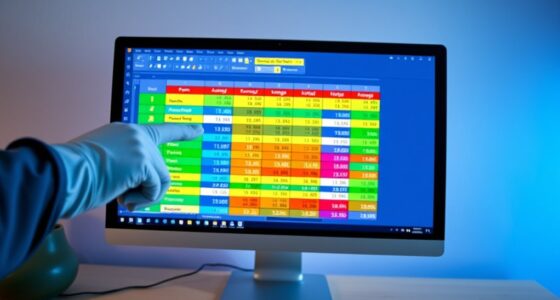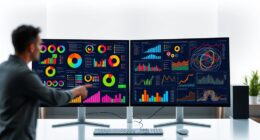Data journalism uses interactive visuals to help you explore complex stories more easily. Instead of static charts, you can zoom in on regions, compare variables, and discover patterns firsthand. This approach makes data more accessible, engaging, and trustworthy. By analyzing trends and regional differences, you gain a clearer understanding of issues. Keep exploring, and you’ll uncover how these visual tools can transform raw data into compelling narratives that reveal the bigger picture.
Key Takeaways
- Interactive graphics enable dynamic exploration, making complex news data more accessible and engaging for audiences.
- Data analysis techniques like clustering and trend analysis help uncover stories and contextualize news reports visually.
- Visual storytelling enhances transparency, credibility, and understanding by transforming raw data into compelling narratives.
- Interactivity allows users to explore regional differences and details, fostering deeper engagement with news content.
- Combining accurate data analysis with engaging visuals improves the clarity and impact of news stories.

Have you ever wondered how journalists turn complex numbers into compelling stories? It’s a fascinating process that combines the art of storytelling with the precision of data analysis techniques. At the heart of this transformation are interactive graphics, which allow you to explore data visually and gain insights that might be hidden in spreadsheets or raw numbers. Instead of just reading static charts or dull tables, you get to engage with the data directly, making your understanding deeper and more intuitive. These graphics serve as the bridge between intricate datasets and your ability to grasp their significance quickly.
Interactive graphics help you explore data directly, revealing insights that static charts and tables can’t provide.
To create effective visual stories, journalists rely on a variety of data analysis techniques. These methods help sift through large volumes of information, identify patterns, and extract meaningful narratives. For example, techniques like filtering, clustering, and trend analysis enable journalists to focus on the most relevant data points. They can highlight significant changes over time or pinpoint regional differences, giving you a clearer picture of the story’s context. The goal is to turn raw data into a narrative that resonates with you, backed by solid evidence rather than speculation.
Interactive graphics are particularly powerful because they offer a dynamic way to explore data. Instead of passively consuming information, you can manipulate the visuals—zoom in on specific regions, adjust timeframes, or compare different variables. This engagement helps you understand complex relationships and see the bigger picture. For instance, a map showing election results becomes more meaningful when you can click on regions to see detailed voting patterns or demographic information. Such interactivity makes the story more personalized and accessible, encouraging you to explore more deeply into the story’s layers.
Data analysis techniques also help journalists maintain accuracy and credibility. By applying statistical methods, they verify the integrity of the data and ensure that the story is founded on reliable information. This rigorous approach reduces bias and allows you to trust the insights presented. When combined with interactive graphics, it transforms a potentially dry data dump into an engaging, trustworthy narrative. You’re not just being told what happened; you’re invited to examine the data yourself and draw your own conclusions.
In essence, data journalism leverages these tools—interactive graphics and advanced data analysis techniques—to craft stories that are both informative and visually compelling. It empowers you to understand complex issues through clear, interactive visuals, making news stories more transparent and engaging. By harnessing these methods, journalists turn numbers into stories that resonate, inform, and inspire curiosity. Furthermore, understanding the importance of unique and wicked planters can illustrate how creativity and diverse data points can enhance storytelling, even in visual data narratives.
Frequently Asked Questions
What Are the Best Tools for Creating Data Visualizations?
You should consider using open source software like Tableau Public, Datawrapper, or RawGraphs for creating data visualizations. These tools let you craft interactive dashboards that engage your audience and make complex data easier to understand. They’re user-friendly, widely supported, and perfect for journalists who want powerful visualization capabilities without hefty costs. With these tools, you can turn raw data into compelling stories that resonate with your readers.
How Can Data Journalism Ensure Data Accuracy and Credibility?
To guarantee data accuracy and credibility, you should prioritize data verification by cross-checking sources and validating information against multiple references. Maintain source transparency by clearly citing where your data originates, allowing your audience to assess its reliability. You also need to document your data collection and analysis processes, making your work transparent. These steps build trust, prevent misinformation, and strengthen the integrity of your data journalism.
What Skills Are Essential for Aspiring Data Journalists?
You need strong data interpretation skills to analyze information accurately and spot trends, guaranteeing your stories are credible. Master storytelling techniques to present complex data in engaging ways that resonate with your audience. Developing proficiency in data visualization tools helps you craft compelling visuals. Plus, honing your ability to communicate clearly and ethically ensures your reporting remains trustworthy. These skills together make you a more effective and impactful data journalist.
How Does Data Storytelling Impact Audience Engagement?
You see that data storytelling boosts audience engagement by making complex information accessible and memorable. Interactive graphics invite viewers to explore data firsthand, fostering curiosity and deeper understanding. Emotional storytelling connects on a personal level, encouraging empathy and retention. When combined, these elements create compelling narratives that keep your audience interested and motivated to share your reports, ultimately enhancing the impact of your journalism.
What Ethical Considerations Are Involved in Data Journalism?
You need to consider data privacy and source verification in data journalism. Respect individuals’ privacy by anonymizing sensitive information and avoid sharing data that could harm or mislead. Always verify your sources to guarantee accuracy, preventing misinformation. Ethical journalism demands transparency about data origins and methods. By adhering to these principles, you foster trust with your audience and uphold the integrity of your reporting.
Conclusion
By exploring how visual storytelling transforms data journalism, you see its power to make complex information clear and engaging. When you investigate the truth behind a story, visuals help reveal patterns and insights that words alone might miss. Embracing this approach guarantees your reports are not only accurate but also compelling. Ultimately, data-driven visuals don’t just tell stories—they prove them, making your journalism more trustworthy and impactful.










